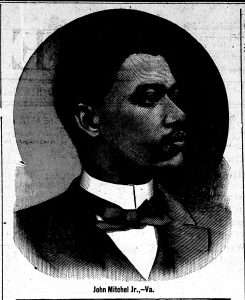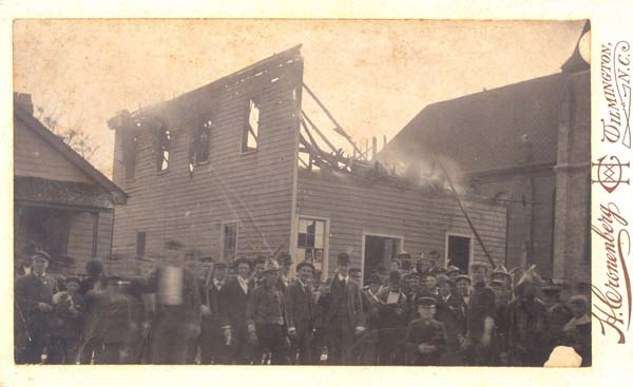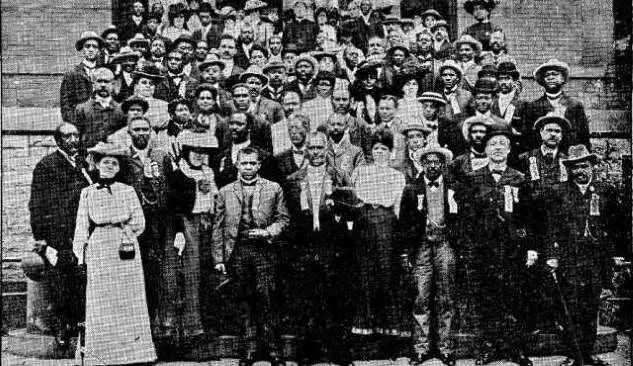The story was long forgotten: A New Haven bootblack became a leader in the fight against Jim Crow as president of a statewide civil rights group, the Sumner League. Forgotten, that is, until the Connecticut Digital Newspaper Project researched African-Americans’ struggle for civil rights in Gilded Age Connecticut.
Librarians digitizing the New Haven Daily Morning Journal and Courier (1880-1907) discovered more than 30 news stories about the State Sumner League of Connecticut. Joseph P. Peaker, its president, was one of New Haven’s many bootblacks operating on New Haven Green or in bootblack parlors.
On August 22, 1894, Peaker and about 200 Connecticut African-American leaders met at J.W. Stewart’s cafe (also described as a ‘casino’ and ‘pavilion’) at Savin Rock. The seaside resort in West Haven once rivaled Coney Island. There the men formed a new organization for the “betterment of the conditions of Afro-Americans.”
The Sumner League played a prominent role in post-Reconstruction campaigns against lynching and disenfranchisement in the South. It also fought discrimination in public accommodations in the North. Peaker was involved in national civil rights actions alongside W.E.B. Du Bois and Booker T. Washington.
Sumner League
The State Sumner League of Connecticut was considered a club of the Republican Party – the party of Lincoln. Its purpose was ‘the improvement and advancement of the colored citizens of Connecticut to the end of healthy and material progress—politically, socially, intellectually, and morally’ (Daily Morning Journal and Courier, Aug. 23, 1894).
The League had chapters throughout the state with ladies’ auxiliaries. It held annual meetings, during which a baseball game was held for the state’s ‘colored championship.’ (Daily Morning Journal and Courier, Aug. 27, 1898).
The Sumner League was responding to deepening discrimination in the North and to the frightening advance of segregation, disenfranchisement and criminal violence in the South. The founders of the Sumner League asserted the right of all citizens to ‘every civil right without distinction or account of birth, race or previous social status.’
Within a few years of its founding, the Sumner League was mentioned in several of the most important African-American newspapers in the country.
President Joseph P. Peaker (1852-1937) generated the most news about the League. In 1896, he was reported to be serving as president of an 1896 ‘colored convention’ in Boston. In other years he was listed as a member of the executive committee of the major civil rights organization of the time, the National Afro-American Council (1898-1907).
Mitchell Tour
When the legendary newspaper editor John J. Mitchell, Jr., toured Connecticut in 1897, Peaker played a key role. The outspoken Mitchell was a living legend who at great personal peril used his newspaper, the Richmond Planet, to crusade against lynching. Thus, his appearance in Connecticut was widely covered. On March 26, he spoke in New Haven to a crowd of about 300 on “Outrages in the South and the Lunenburg Case.”
Mitchell spoke for an hour about the many cases of unjustified imprisonment and lynching of African-Americans in Virginia, according to the account of his talk in the Planet. Black Connecticut leaders congratulated him for his efforts to free three innocent women— Pokey Barnes, Mary Barnes, and Mary Abernathy. They were unfairly accused of murder in Lunenburg County, Virginia, and sentenced to death.
Mitchell left a fascinating and detailed first-hand account of his Connecticut tour. He discussed the people he met and places of interest he visited (Richmond Planet, April 3, 1897, p. 1, cols. 7-9). In it, he described Joseph Peaker as ‘an original character, a race man through and through, a polished speaker, using chaste English,’ and ‘in his glory’ at the podium.
Black Lives Mattered
Joseph Peaker took his fight against Jim Crow beyond Connecticut after African-Americans were murdered in the Carolinas. He was involved in national civil rights actions central to the period, speaking at a historic meeting in New York City, rubbing shoulders with the great African-American figures of his time and serving as a leader of the group that arguably was the predecessor to the NAACP.
A year after the Mitchell tour, in 1898, Peaker appears in a national wire service story about a historic mass meeting at Cooper Union in New York City (Daily Morning Journal and Courier, Nov. 18, 1898, p. 1, col. 4)). He is said to have made brief remarks, sharing the stage with such prominent African-Americans as New York Age editor Thomas T. Fortune and Ebeneezer J. Barrett, the former U.S. minister to Haiti.
The Cooper Union meeting was called in response to the Wilmington, N.C., race riot. A former Confederate officer and white supremacist led an armed band of 500 townspeople in forcing the ouster of the Republican town government and burning the offices of the Daily Record. Many African-Americans fled to safety, but 14 black residents were killed.
The Cooper Union meeting not only condemned this violence, but resolved to protest the constitutional changes that allowed Mississippi, South Carolina and Louisiana to disenfranchise more than half their populations. It also called upon the federal government to pass a constitutional amendment that would allow the president to use federal troops to protect African-American lives in the southern states.
The Sumner League and the NAAC
Many of the people speaking out at the Cooper Union went on to found an important organization, the National Afro-American Council.
By 1899, Peaker, again identified as president of the Sumner League of Connecticut, is listed as part of the executive committee of the new group. He was in the company of some of the most important black leaders in the country: Fortune, Mitchell, Bishop Alexander Walters, Ida B. Wells, Mary Church Terrell, W.E.B. Dubois and Booker T. Washington.
The council’s general mission was to dismantle segregationist Jim Crow legislation. But the immediate impetus for its formation was the mob assault and murder of the African-American postmaster, Frazier Baker, and his daughter in Lake City, S.C.
Their work on the behalf of Baker, and many others, consciously bridged the range of strategies found in the movement at the time. Perhaps uniquely, they urged both protest and self-help, and were admired because they were granted annual meetings with President William McKinley.
The NAAC’s effectiveness has been debated. Contemporary scholar Shawn Leigh Alexander, though, argues in his book An Army of Lions that it played a critical role and laid the foundation for the founding of the NAACP in 1909.
The New Haven Daily Morning Journal and Courier run (1880-1907) that carries the stories about the Sumner League has been digitized by the Connecticut Digital Newspaper Project. It is searchable in the Library of Congress database of historic newspapers known as Chronicling America.
Stories about African-American Gilded Age Connecticut in state newspapers like the Journal and Courier will be easily contextualized when compared with related articles from the dozens of key African-American newspapers already in the database. For the Gilded Age, these include the Richmond Planet, the Washington Bee and the Saint Paul and Minneapolis Appeal.
The author of this story is Christine Gauvreau, Project Coordinator, CT Digital Newspaper Project, an initiative of the CT State Library.
For Further Research
Alexander, Shawn Leigh. An Army of Lions: The Civil Rights Struggle before the NAACP. Philadelphia: University of Pennsylvania Press, 2012.
Opsahl, Alexander J. “Afro-American Council (1898-1907)” at BlackPast.org. Accessed on July 15, 2016 at http://www.blackpast.org/aah/afro-american-council-1898-1907.
Warner, Robert Austin. New Haven Negroes: A Social History. New Haven: Yale University Press, 1940, pp. 178-181. State Library Catalog Record at http://www.consuls.org:80/record=b1760232~S1.
This story updated in 2022.





3 comments
[…] story, Blanche said she went to her dressmaker. She saw Jennie on a horse-pulled trolley headed to Savin Rock in West Haven, home of an amusement park. It was the last she ever saw of Jennie – or so she […]
[…] the New England roots of W.E.B. Du Bois as shaping his personality and inspiring his drive to overcome racism with rigorous intellectual argument. Here are five facts about New England and Du […]
[…] the New England roots of W.E.B. Du Bois as shaping his personality and inspiring his drive to overcome racism with rigorous intellectual […]
Comments are closed.